The Cambridge History of Japan, Vol. 3: Medieval Japan
Подождите немного. Документ загружается.

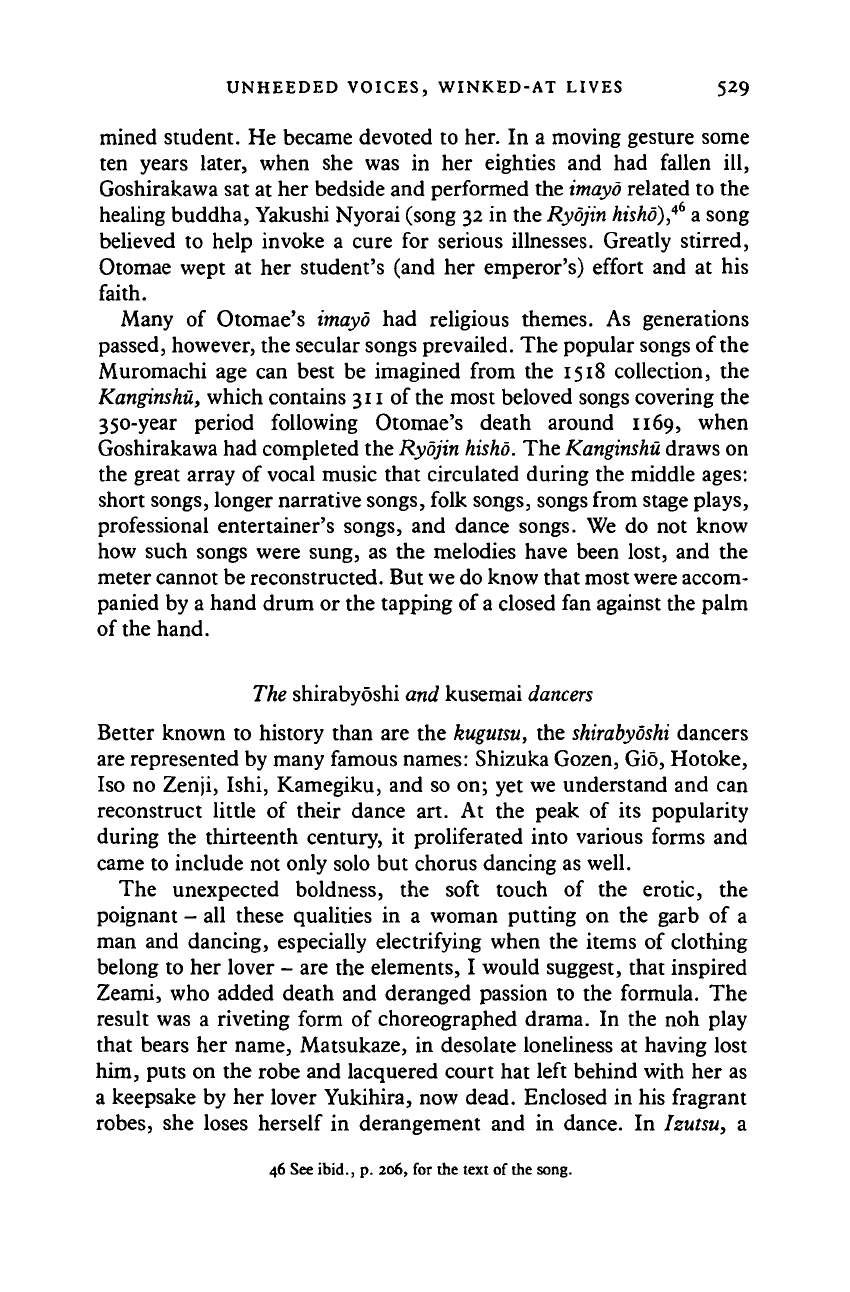
UNHEEDED VOICES, WINKED-AT LIVES 529
mined student. He became devoted to her. In a moving gesture some
ten years later, when she was in her eighties and had fallen ill,
Goshirakawa sat at her bedside and performed the imayo related to the
healing buddha, Yakushi Nyorai (song 32 in the Ryojin
hisho),*
6
a song
believed to help invoke a cure for serious illnesses. Greatly stirred,
Otomae wept at her student's (and her emperor's) effort and at his
faith.
Many of Otomae's imayo had religious themes. As generations
passed, however, the secular songs prevailed. The popular songs of the
Muromachi age can best be imagined from the 1518 collection, the
Kanginshu, which contains 311 of the most beloved songs covering the
350-year period following Otomae's death around 1169, when
Goshirakawa had completed the Ryojin hisho. The Kanginshu draws on
the great array of vocal music that circulated during the middle ages:
short songs, longer narrative songs, folk songs, songs from stage plays,
professional entertainer's songs, and dance songs. We do not know
how such songs were sung, as the melodies have been lost, and the
meter cannot be reconstructed. But we do know that most were accom-
panied by a hand drum or the tapping of a closed fan against the palm
of the hand.
The shirabyoshi and kusemai
dancers
Better known to history than are the kugutsu, the
shirabyoshi
dancers
are represented by many famous names: Shizuka Gozen, Gio, Hotoke,
Iso no Zenji, Ishi, Kamegiku, and so on; yet we understand and can
reconstruct little of their dance art. At the peak of its popularity
during the thirteenth century, it proliferated into various forms and
came to include not only solo but chorus dancing as well.
The unexpected boldness, the soft touch of the erotic, the
poignant - all these qualities in a woman putting on the garb of a
man and dancing, especially electrifying when the items of clothing
belong to her lover - are the elements, I would suggest, that inspired
Zeami, who added death and deranged passion to the formula. The
result was a riveting form of choreographed drama. In the noh play
that bears her name, Matsukaze, in desolate loneliness at having lost
him, puts on the robe and lacquered court hat left behind with her as
a keepsake by her lover Yukihira, now dead. Enclosed in his fragrant
robes,
she loses herself in derangement and in dance. In Izutsu, a
46 See ibid., p. 206, for the text of the song.
Cambridge Histories Online © Cambridge University Press, 2008
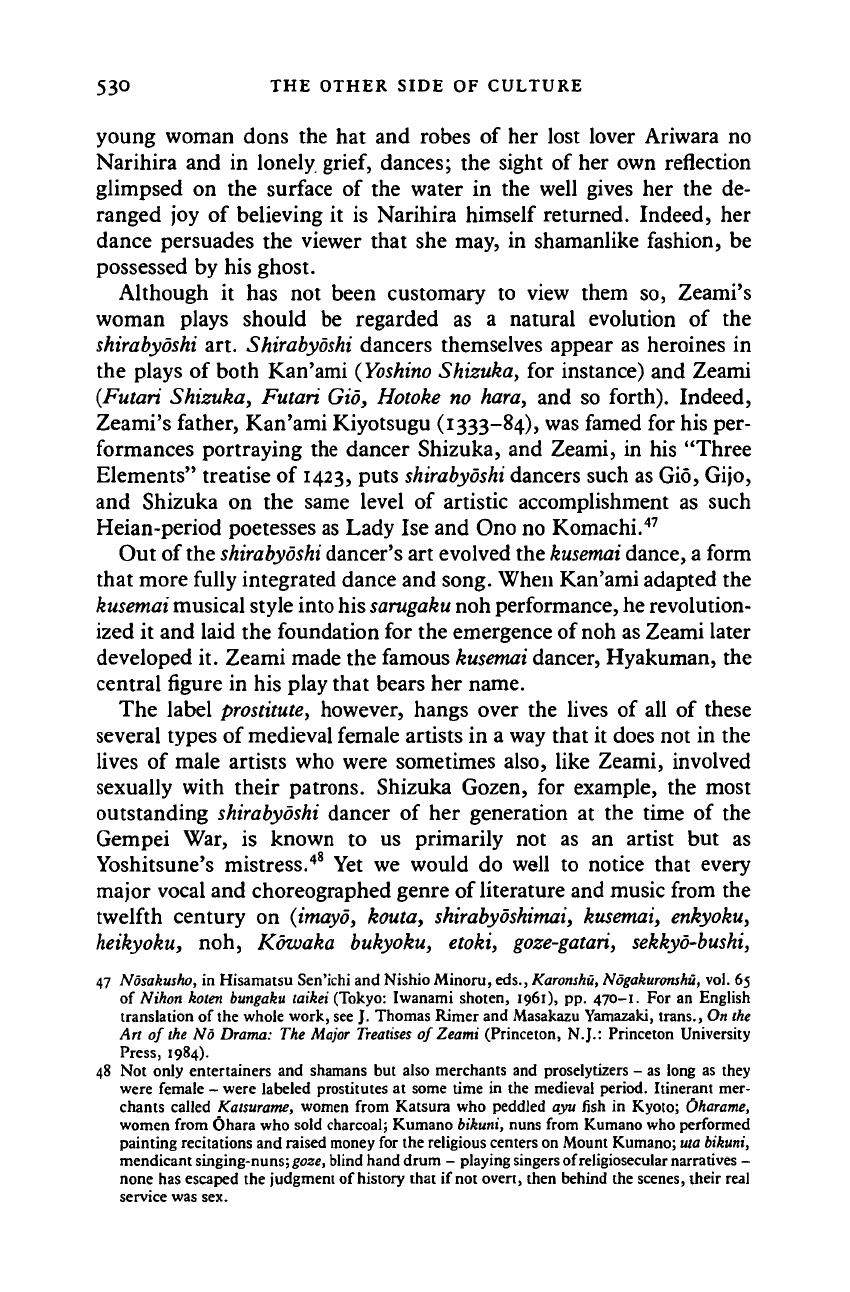
53° THE OTHER SIDE OF CULTURE
young woman dons the hat and robes of her lost lover Ariwara no
Narihira and in lonely,
grief,
dances; the sight of her own reflection
glimpsed on the surface of the water in the well gives her the de-
ranged joy of believing it is Narihira himself returned. Indeed, her
dance persuades the viewer that she may, in shamanlike fashion, be
possessed by his ghost.
Although it has not been customary to view them so, Zeami's
woman plays should be regarded as a natural evolution of the
shirabyoshi
art.
Shirabyoshi
dancers themselves appear as heroines in
the plays of both Kan'ami
(Yoshino
Shizuka, for instance) and Zeami
(Futari Shizuka, Futari Gio, Hotoke no hara, and so forth). Indeed,
Zeami's father, Kan'ami Kiyotsugu (1333-84), was famed for his per-
formances portraying the dancer Shizuka, and Zeami, in his "Three
Elements" treatise of
1423,
puts
shirabyoshi
dancers such as Gio, Gijo,
and Shizuka on the same level of artistic accomplishment as such
Heian-period poetesses as Lady Ise and Ono no Komachi.
47
Out of the
shirabyoshi
dancer's art evolved the
kusemai
dance, a form
that more fully integrated dance and song. When Kan'ami adapted the
kusemai
musical style into his
sarugaku
noh performance, he revolution-
ized it and laid the foundation for the emergence of noh as Zeami later
developed it. Zeami made the famous
kusemai
dancer, Hyakuman, the
central figure in his play that bears her name.
The label
prostitute,
however, hangs over the lives of all of these
several types of medieval female artists in a way that it does not in the
lives of male artists who were sometimes also, like Zeami, involved
sexually with their patrons. Shizuka Gozen, for example, the most
outstanding
shirabyoshi
dancer of her generation at the time of the
Gempei War, is known to us primarily not as an artist but as
Yoshitsune's mistress.
48
Yet we would do well to notice that every
major vocal and choreographed genre of literature and music from the
twelfth century on (imayo, kouta, shirabyoshimai, kusemai, enkyoku,
heikyoku, noh, Kowaka bukyoku, etoki, goze-gatari, sekkyo-bushi,
47 Nosakusho, in Hisamatsu Sen'ichi and Nishio Minoru, eds.,
Karonshu,
Nogakuronshu,
vol. 65
of Nihon koten bungaku taikei (Tokyo: Iwanami shoten, 1961), pp.
470-1.
For an English
translation of the whole work, see J. Thomas Rimer and Masakazu Yamazaki, trans., On the
Art of the No Drama: The Major
Treatises
of Zeami (Princeton, N.J.: Princeton University
Press,
1984).
48 Not only entertainers and shamans but also merchants and proselytizers - as long as they
were female - were labeled prostitutes at some time in the medieval period. Itinerant mer-
chants called Kaisurame, women from Katsura who peddled ayu fish in Kyoto; Oharame,
women from Ohara who sold charcoal; Kumano bikuni, nuns from Kumano who performed
painting recitations and raised money for the religious centers on Mount Kumano; uta bikuni,
mendicant
singing-nuns;
goze, blind hand drum - playing singers of religiosecular narratives -
none has escaped the judgment of history that if not overt, then behind the scenes, their real
service was sex.
Cambridge Histories Online © Cambridge University Press, 2008
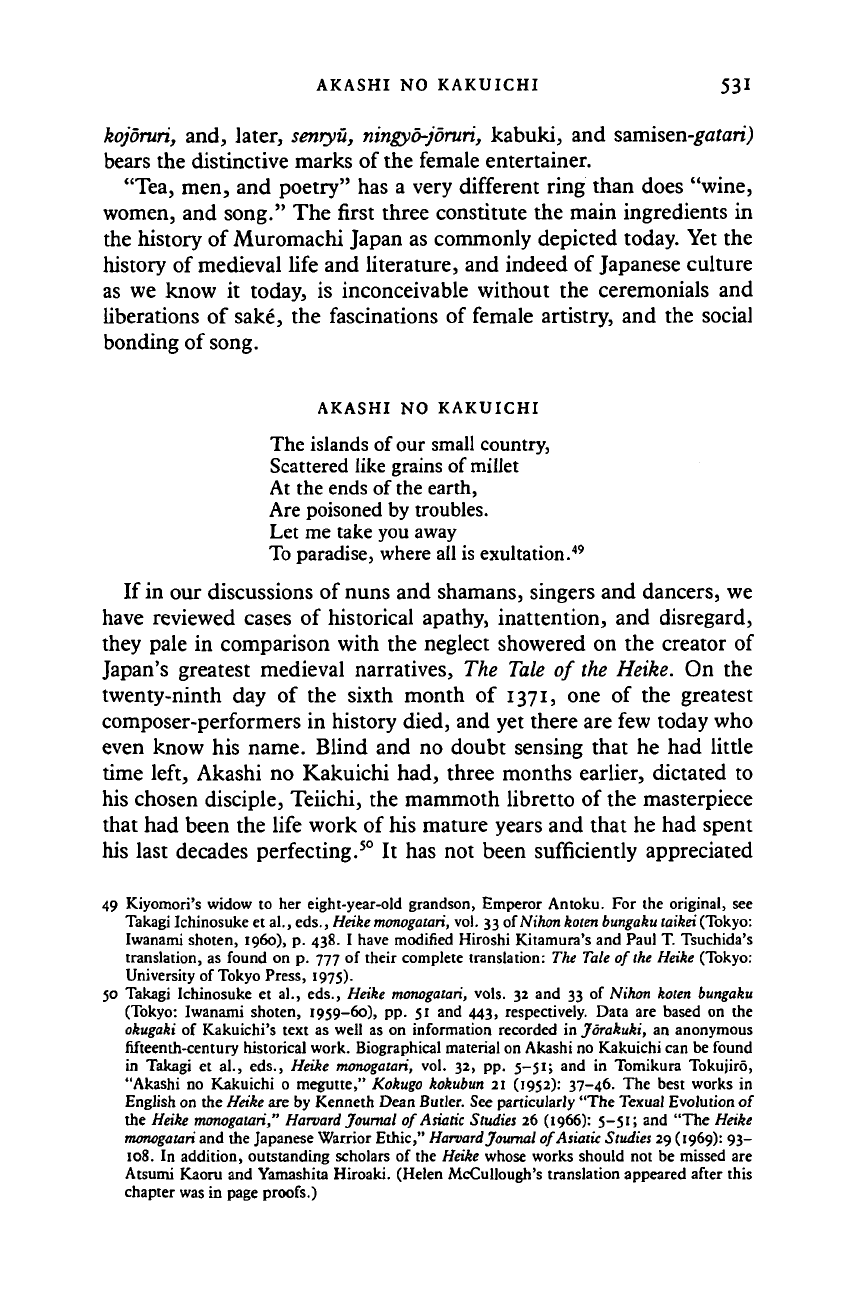
AKASHI NO KAKUICHI 531
kojoruri, and, later, senryu, ningyo-joruri, kabuki, and samisen-gafari,)
bears the distinctive marks of the female entertainer.
"Tea, men, and poetry" has a very different ring than does "wine,
women, and song." The first three constitute the main ingredients in
the history of Muromachi Japan as commonly depicted today. Yet the
history of medieval hfe and literature, and indeed of Japanese culture
as we know it today, is inconceivable without the ceremonials and
liberations of sake, the fascinations of female artistry, and the social
bonding of song.
AKASHI NO KAKUICHI
The islands of our small country.
Scattered like grains of millet
At the ends of the earth,
Are poisoned by troubles.
Let me take you away
To paradise, where all is exultation.
49
If in our discussions of nuns and shamans, singers and dancers, we
have reviewed cases of historical apathy, inattention, and disregard,
they pale in comparison with the neglect showered on the creator of
Japan's greatest medieval narratives, The Tale of the Heike. On the
twenty-ninth day of the sixth month of 1371, one of the greatest
composer-performers in history died, and yet there are few today who
even know his name. Blind and no doubt sensing that he had little
time left, Akashi no Kakuichi had, three months earlier, dictated to
his chosen disciple, Teiichi, the mammoth libretto of the masterpiece
that had been the life work of his mature years and that he had spent
his last decades perfecting.
50
It has not been sufficiently appreciated
49 Kiyomori's widow to her eight-year-old grandson, Emperor Antoku. For the original, see
Takagi Ichinosuke et al., eds., Heike
monogatari,
vol. 33 of Nihon
koten bungaku taikei
(Tokyo:
Iwanami shoten, 1960), p. 438. I have modified Hiroshi Kitamura's and Paul T. Tsuchida's
translation, as found on p. 777 of their complete translation: The Tale of
ike
Heike (Tokyo:
University of Tokyo Press, 1975).
50 Takagi Ichinosuke et al., eds., Heike
monogatari,
vols. 32 and 33 of Nihon koten bungaku
(Tokyo: Iwanami shoten, 1959-60), pp. 51 and 443, respectively. Data are based on the
okugaki of Kakuichi's text as well as on information recorded in Jorakuki, an anonymous
fifteenth-century historical work. Biographical material on Akashi no Kakuichi can be found
in Takagi et al., eds., Heike monogatari, vol. 32, pp. 5-51; and in Tomikura Tokujiro,
"Akashi no Kakuichi o megutte," Kokugo kokubun 21 (1952): 37-46. The best works in
English on the Heike are by Kenneth Dean Butler. See particularly "The Texual Evolution of
the Heike
monogatari,"
Harvard Journal of
Asiatic
Studies 26 (1966): 5-51; and "The Heike
monogatari
and the Japanese Warrior Ethic," Harvard Journal of Asiatic Studies 29 (1969): 93-
108.
In addition, outstanding scholars of the Heike whose works should not be missed are
Atsumi Kaom and Yamashita Hiroaki. (Helen McCullough's translation appeared after this
chapter was in page proofs.)
Cambridge Histories Online © Cambridge University Press, 2008
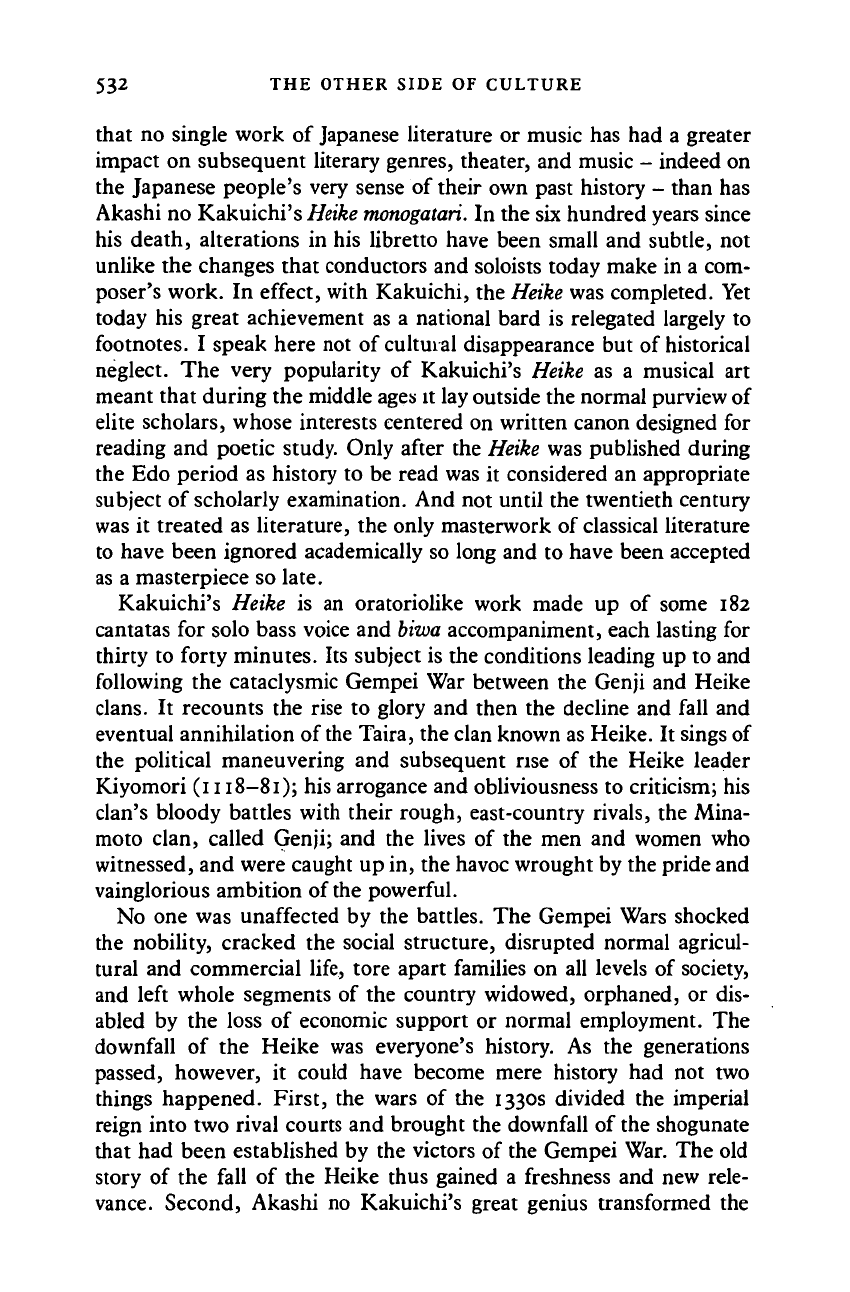
532 THE OTHER SIDE OF CULTURE
that no single work of Japanese literature or music has had a greater
impact on subsequent literary genres, theater, and music - indeed on
the Japanese people's very sense of their own past history - than has
Akashi no Kakuichi's
Heike
monogatari.
In the six hundred years since
his death, alterations in his libretto have been small and subtle, not
unlike the changes that conductors and soloists today make in a com-
poser's work. In effect, with Kakuichi, the
Heike
was completed. Yet
today his great achievement as a national bard is relegated largely to
footnotes. I speak here not of cultural disappearance but of historical
neglect. The very popularity of Kakuichi's Heike as a musical art
meant that during the middle ages it lay outside the normal purview
of
elite scholars, whose interests centered on written canon designed for
reading and poetic study. Only after the
Heike
was published during
the Edo period as history to be read was it considered an appropriate
subject of scholarly examination. And not until the twentieth century
was it treated as literature, the only masterwork of classical literature
to have been ignored academically so long and to have been accepted
as a masterpiece so late.
Kakuichi's Heike is an oratoriolike work made up of some 182
cantatas for solo bass voice and
biwa
accompaniment, each lasting for
thirty to forty minutes. Its subject is the conditions leading up to and
following the cataclysmic Gempei War between the Genji and Heike
clans.
It recounts the rise to glory and then the decline and fall and
eventual annihilation of
the
Taira, the clan known as Heike. It sings of
the political maneuvering and subsequent rise of the Heike leader
Kiyomori (1118-81); his arrogance and obliviousness to criticism; his
clan's bloody battles with their rough, east-country rivals, the Mina-
moto clan, called Genji; and the lives of the men and women who
witnessed, and were caught up in, the havoc wrought by the pride and
vainglorious ambition of the powerful.
No one was unaffected by the battles. The Gempei Wars shocked
the nobility, cracked the social structure, disrupted normal agricul-
tural and commercial life, tore apart families on all levels of society,
and left whole segments of the country widowed, orphaned, or dis-
abled by the loss of economic support or normal employment. The
downfall of the Heike was everyone's history. As the generations
passed, however, it could have become mere history had not two
things happened. First, the wars of the 1330s divided the imperial
reign into two rival courts and brought the downfall of the shogunate
that had been established by the victors of the Gempei War. The old
story of the fall of the Heike thus gained a freshness and new rele-
vance. Second, Akashi no Kakuichi's great genius transformed the
Cambridge Histories Online © Cambridge University Press, 2008
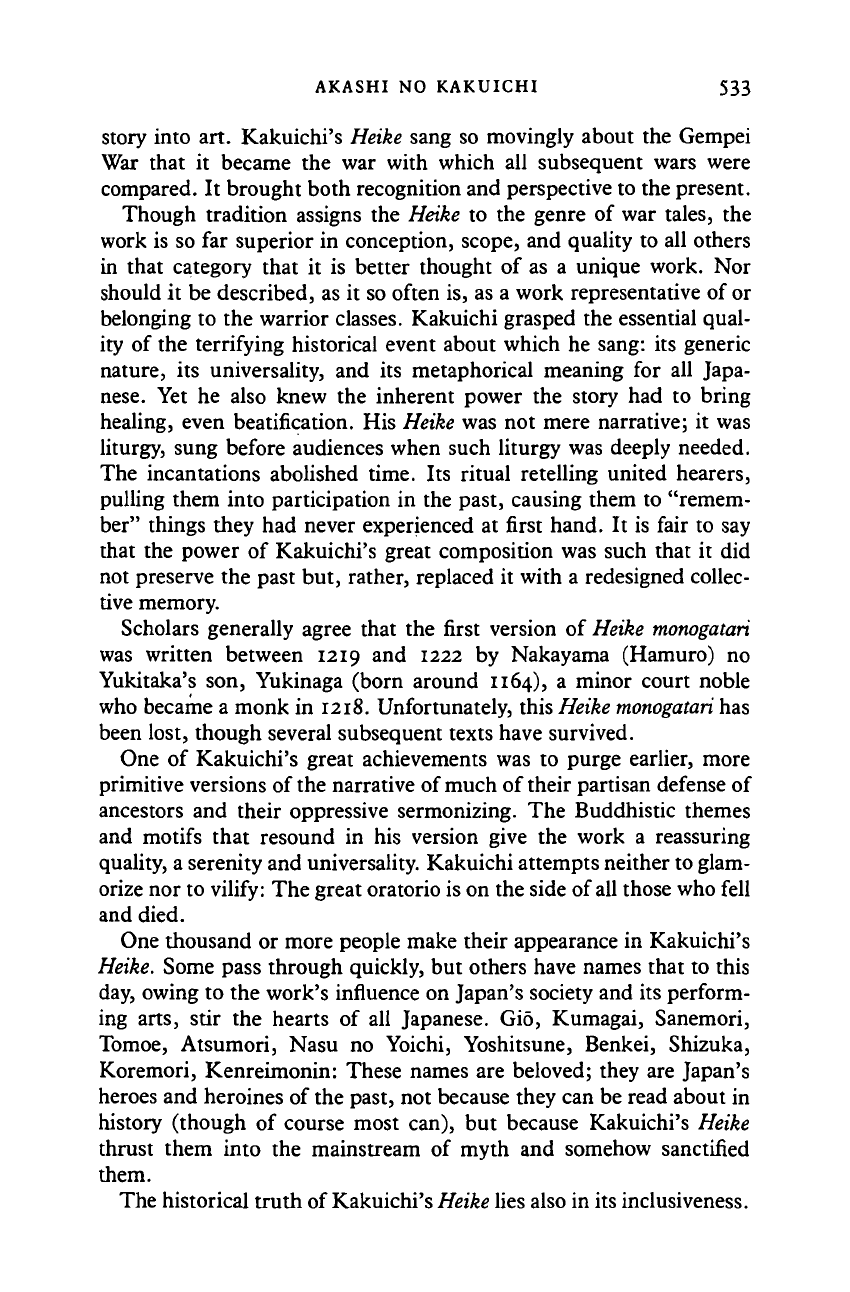
AKASHI NO KAKUICHI 533
story into art. Kakuichi's Heike sang so movingly about the Gempei
War that it became the war with which all subsequent wars were
compared. It brought both recognition and perspective to the present.
Though tradition assigns the Heike to the genre of war tales, the
work is so far superior in conception, scope, and quality to all others
in that category that it is better thought of as a unique work. Nor
should it be described, as it so often is, as a work representative of or
belonging to the warrior classes. Kakuichi grasped the essential qual-
ity of the terrifying historical event about which he sang: its generic
nature, its universality, and its metaphorical meaning for all Japa-
nese.
Yet he also knew the inherent power the story had to bring
healing, even beatification. His
Heike
was not mere narrative; it was
liturgy, sung before audiences when such liturgy was deeply needed.
The incantations abolished time. Its ritual retelling united hearers,
pulling them into participation in the past, causing them to "remem-
ber" things they had never experienced at first hand. It is fair to say
that the power of Kakuichi's great composition was such that it did
not preserve the past but, rather, replaced it with a redesigned collec-
tive memory.
Scholars generally agree that the first version of
Heike monogatari
was written between 1219 and 1222 by Nakayama (Hamuro) no
Yukitaka's son, Yukinaga (born around 1164), a minor court noble
who became a monk in 1218. Unfortunately, this
Heike monogatari
has
been lost, though several subsequent texts have survived.
One of Kakuichi's great achievements was to purge earlier, more
primitive versions of the narrative of much of their partisan defense of
ancestors and their oppressive sermonizing. The Buddhistic themes
and motifs that resound in his version give the work a reassuring
quality, a serenity and universality. Kakuichi attempts neither to glam-
orize nor to vilify: The great oratorio is on the side of all those who fell
and died.
One thousand or more people make their appearance in Kakuichi's
Heike. Some pass through quickly, but others have names that to this
day, owing to the work's influence on Japan's society and its perform-
ing arts, stir the hearts of all Japanese. Gio, Kumagai, Sanemori,
Tomoe, Atsumori, Nasu no Yoichi, Yoshitsune, Benkei, Shizuka,
Koremori, Kenreimonin: These names are beloved; they are Japan's
heroes and heroines of the past, not because they can be read about in
history (though of course most can), but because Kakuichi's Heike
thrust them into the mainstream of myth and somehow sanctified
them.
The historical truth of Kakuichi's
Heike
lies also in its inclusiveness.
Cambridge Histories Online © Cambridge University Press, 2008
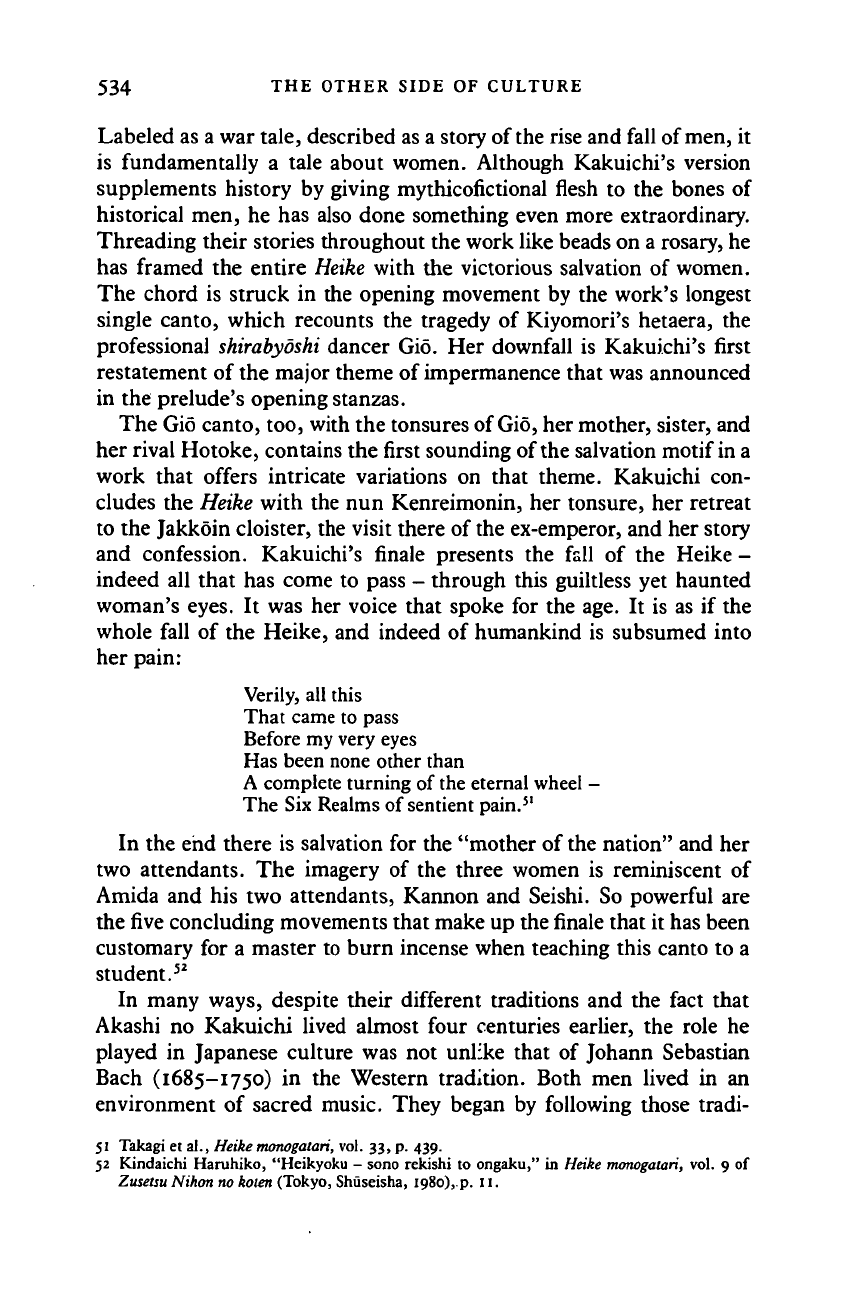
534 THE OTHER SIDE OF CULTURE
Labeled as a war tale, described as a story of the rise and fall of men, it
is fundamentally a tale about women. Although Kakuichi's version
supplements history by giving mythicofictional flesh to the bones of
historical men, he has also done something even more extraordinary.
Threading their stories throughout the work like beads on a rosary, he
has framed the entire
Heike
with the victorious salvation of women.
The chord is struck in the opening movement by the work's longest
single canto, which recounts the tragedy of Kiyomori's hetaera, the
professional
shirabyoshi
dancer Gio. Her downfall is Kakuichi's first
restatement of the major theme of impermanence that was announced
in the prelude's opening stanzas.
The Gio canto, too, with the tonsures of
Gio,
her mother, sister, and
her rival Hotoke, contains the first sounding of
the
salvation motif
in a
work that offers intricate variations on that theme. Kakuichi con-
cludes the Heike with the nun Kenreimonin, her tonsure, her retreat
to the Jakkoin cloister, the visit there of the ex-emperor, and her story
and confession. Kakuichi's finale presents the fall of the Heike -
indeed all that has come to pass - through this guiltless yet haunted
woman's eyes. It was her voice that spoke for the age. It is as if the
whole fall of the Heike, and indeed of humankind is subsumed into
her pain:
Verily, all this
That came to pass
Before
my
very eyes
Has been none other than
A
complete turning of
the
eternal wheel -
The Six Realms of sentient pain.
5
'
In the end there is salvation for the "mother of the nation" and her
two attendants. The imagery of the three women is reminiscent of
Amida and his two attendants, Kannon and Seishi. So powerful are
the five concluding movements that make up the
finale
that it has been
customary for a master to burn incense when teaching this canto to a
student.
52
In many ways, despite their different traditions and the fact that
Akashi no Kakuichi lived almost four centuries earlier, the role he
played in Japanese culture was not unlike that of Johann Sebastian
Bach (1685-1750) in the Western tradition. Both men lived in an
environment of sacred music. They began by following those tradi-
51 Takagi
et al.,
Heike
monogatari,
vol. 33, p. 439.
52 Kindaichi
Haruhiko,
"Heikyoku
-
sono rekishi
to
ongaku,"
in
Heike
monogatari,
vol. 9 of
Zusetsu Nikon
no
koien
(Tokyo,
Shuseisha,
I98o),.p.
11.
Cambridge Histories Online © Cambridge University Press, 2008
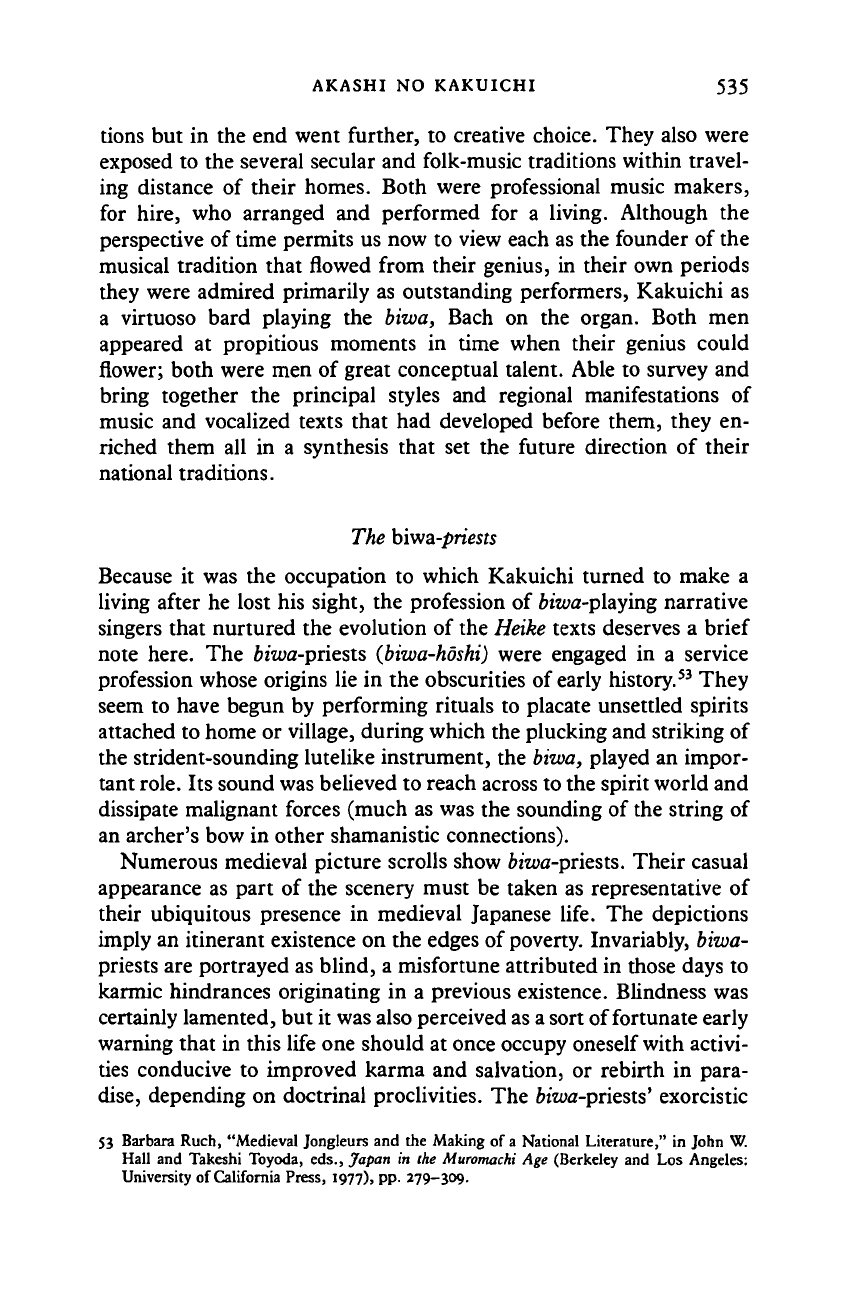
AKASHI NO KAKUICHI 535
tions but in the end went further, to creative choice. They also were
exposed to the several secular and folk-music traditions within travel-
ing distance of their homes. Both were professional music makers,
for hire, who arranged and performed for a living. Although the
perspective of time permits us now to view each as the founder of the
musical tradition that flowed from their genius, in their own periods
they were admired primarily as outstanding performers, Kakuichi as
a virtuoso bard playing the biwa, Bach on the organ. Both men
appeared at propitious moments in time when their genius could
flower; both were men of great conceptual talent. Able to survey and
bring together the principal styles and regional manifestations of
music and vocalized texts that had developed before them, they en-
riched them all in a synthesis that set the future direction of their
national traditions.
The
biv/a-priests
Because it was the occupation to which Kakuichi turned to make a
living after he lost his sight, the profession of
biwa-playing
narrative
singers that nurtured the evolution of the
Heike
texts deserves a brief
note here. The biwa-priests
(biwa-hoshi)
were engaged in a service
profession whose origins lie in the obscurities of early history.
53
They
seem to have begun by performing rituals to placate unsettled spirits
attached to home or village, during which the plucking and striking of
the strident-sounding lutelike instrument, the
biwa,
played an impor-
tant
role.
Its sound was believed to reach across to the spirit world and
dissipate malignant forces (much as was the sounding of the string of
an archer's bow in other shamanistic connections).
Numerous medieval picture scrolls show
biwa-priests.
Their casual
appearance as part of the scenery must be taken as representative of
their ubiquitous presence in medieval Japanese life. The depictions
imply an itinerant existence on the edges of
poverty.
Invariably, biwa-
priests
are portrayed as blind, a misfortune attributed in those days to
karmic hindrances originating in a previous existence. Blindness was
certainly lamented, but it was also perceived as
a
sort of fortunate early
warning that in this life one should at once occupy oneself with activi-
ties conducive to improved karma and salvation, or rebirth in para-
dise,
depending on doctrinal proclivities. The
biwa-priests'
exorcistic
53 Barbara Ruch, "Medieval Jongleurs and the Making of a National Literature," in John W.
Hall and Takeshi Toyoda, eds., Japan in the Muromachi Age (Berkeley and Los Angeles:
University of California Press, 1977), pp. 279-309.
Cambridge Histories Online © Cambridge University Press, 2008
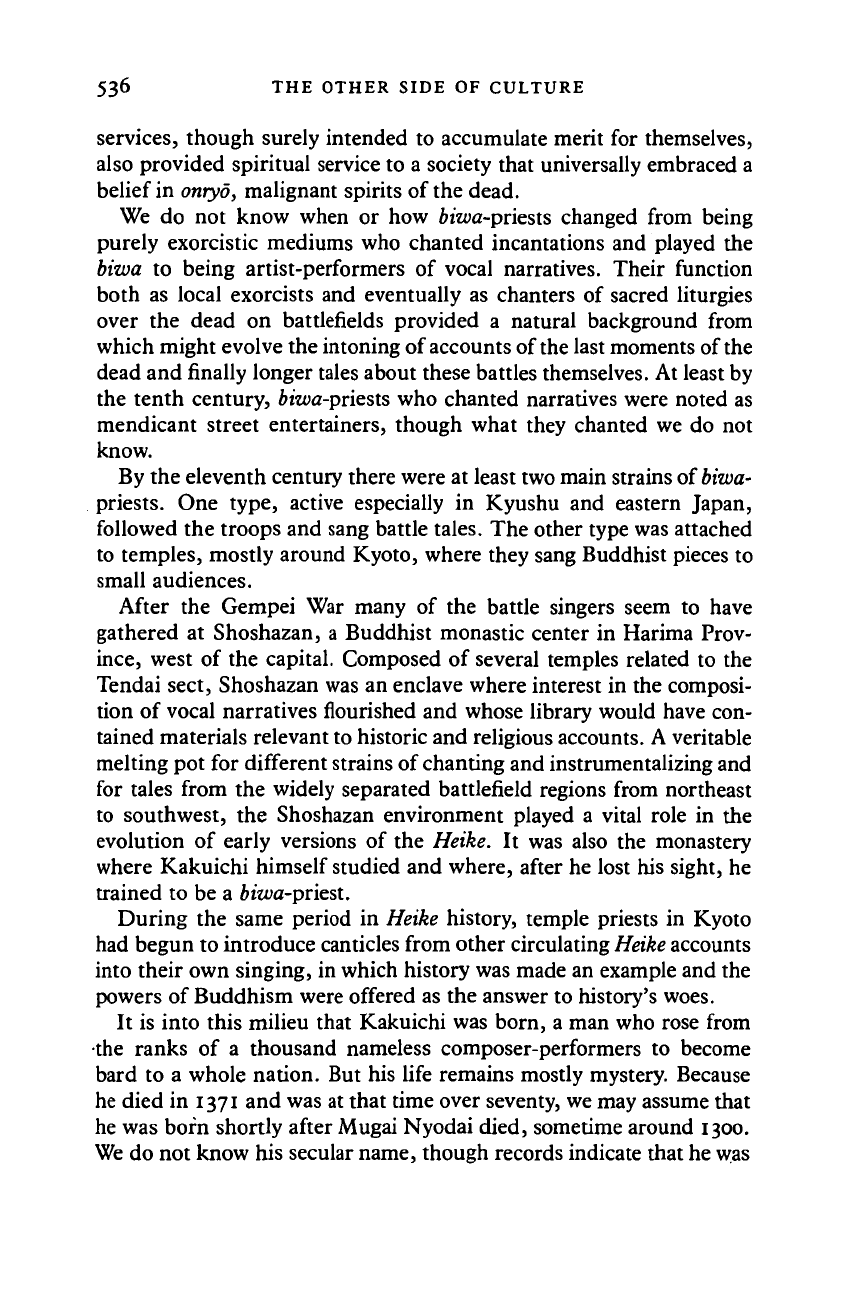
536 THE OTHER SIDE OF CULTURE
services, though surely intended to accumulate merit for themselves,
also provided spiritual service to a society that universally embraced a
belief in
onryo,
malignant spirits of the dead.
We do not know when or how biwa-priests changed from being
purely exorcistic mediums who chanted incantations and played the
biwa to being artist-performers of vocal narratives. Their function
both as local exorcists and eventually as chanters of sacred liturgies
over the dead on battlefields provided a natural background from
which might evolve the intoning of accounts of the last moments of the
dead and finally longer tales about these battles themselves. At least by
the tenth century, ira>a-priests who chanted narratives were noted as
mendicant street entertainers, though what they chanted we do not
know.
By the eleventh century there were at least two main strains of
biwa-
priests. One type, active especially in Kyushu and eastern Japan,
followed the troops and sang battle tales. The other type was attached
to temples, mostly around Kyoto, where they sang Buddhist pieces to
small audiences.
After the Gempei War many of the battle singers seem to have
gathered at Shoshazan, a Buddhist monastic center in Harima Prov-
ince,
west of the capital. Composed of several temples related to the
Tendai sect, Shoshazan was an enclave where interest in the composi-
tion of vocal narratives flourished and whose library would have con-
tained materials relevant to historic and religious accounts. A veritable
melting pot for different strains of chanting and instrumentalizing and
for tales from the widely separated battlefield regions from northeast
to southwest, the Shoshazan environment played a vital role in the
evolution of early versions of the Heike. It was also the monastery
where Kakuichi himself studied and where, after he lost his sight, he
trained to be a fciwa-priest.
During the same period in Heike history, temple priests in Kyoto
had begun to introduce canticles from other circulating
Heike
accounts
into their own singing, in which history was made an example and the
powers of Buddhism were offered as the answer to history's woes.
It is into this milieu that Kakuichi was born, a man who rose from
•the ranks of a thousand nameless composer-performers to become
bard to a whole nation. But his life remains mostly mystery. Because
he died in 1371 and was at that time over seventy, we may assume that
he was born shortly after Mugai Nyodai died, sometime around 1300.
We do not know his secular name, though records indicate that he was
Cambridge Histories Online © Cambridge University Press, 2008

AKASHI NO KAKUICHI 537
referred to as Akashi-dono.
54
Nor do we know the priestly name he
used when, at a fairly youthful age, he became a monk at Shoshazan,
which was located in the mountains not far from Akashi. Known as
"the western Mount Hiei," Shoshazan attracted traveling monks from
throughout Japan. Judging from the later quality of his literary and
musical genius, Kakuichi obtained a good liturgical and musical educa-
tion there. In addition to scriptural study, he probably also learned the
Shoshazan-style of Tendai shomyo, or liturgical vocal music for the
incantation of scriptural texts, as well as a rather fast-paced rhythmical
method of reading sutras, then considered a Shoshazan specialty. He
was surely also familiar with certain styles of enkyoku, or Buddhist
festive melodies, a kind of rhythmic prose song enjoyed by priests in a
party environment at the end of important religious services. Some-
how he also learned the songs called imayo, of the sort Otomae had in
her repertory, as he incorporated them into the Heike.
We have no way to resurrect the melodies or rhythms or the preferred
vocal timbres of these various works, as the system used at the time to
record them constituted merely signs to indicate relative durations and
the general direction of melodic line; music was learned orally by imitat-
ing a teacher. We can only hope that the conservative nature of religious
forms of music makes it possible to hear echoes of the past in the present
forms of Tendai shomyo and in the vocalization of such performing arts
as noh that were influenced by early Buddhist music.
After studying at Shoshazan for some years, Kakuichi lost his eye-
sight while he was still fairly young - no later than his early thirties -
under circumstances that cannot be reconstructed at the present
time.
55
For a priest in a scholarly center where sacred texts were
central to life's daily activities, the blow must have been great. None-
theless, Shoshazan was also a gathering place for fo'zua-priests; that
Kakuichi had readily available such a creative option to turn to and
that there were musician-chanters at Shoshazan under whom to study,
was a momentous confluence of circumstances and a turning point in
Japanese cultural history.
While still a Shoshazan, Kakuichi learned how to perform an early
version of the Heike, now called the Kamakura-fton Heike, that most
likely had been created by &ia>a-playing priests there when he was still
a child. In effect, it was a kind of Shoshazan Heike. After learning to
54 According to the fourteenth-century Heike kammon roku, quoted by Tomikura Tokujiro,
Heike
monogatari
kenkyu (Tokyo: Kadokawa shoten, 1967), p. 283.
55 From the Saikai yoieki shu, quoted by Tomikura, "Akashi no Kakuichi," p. 39.
Cambridge Histories Online © Cambridge University Press, 2008
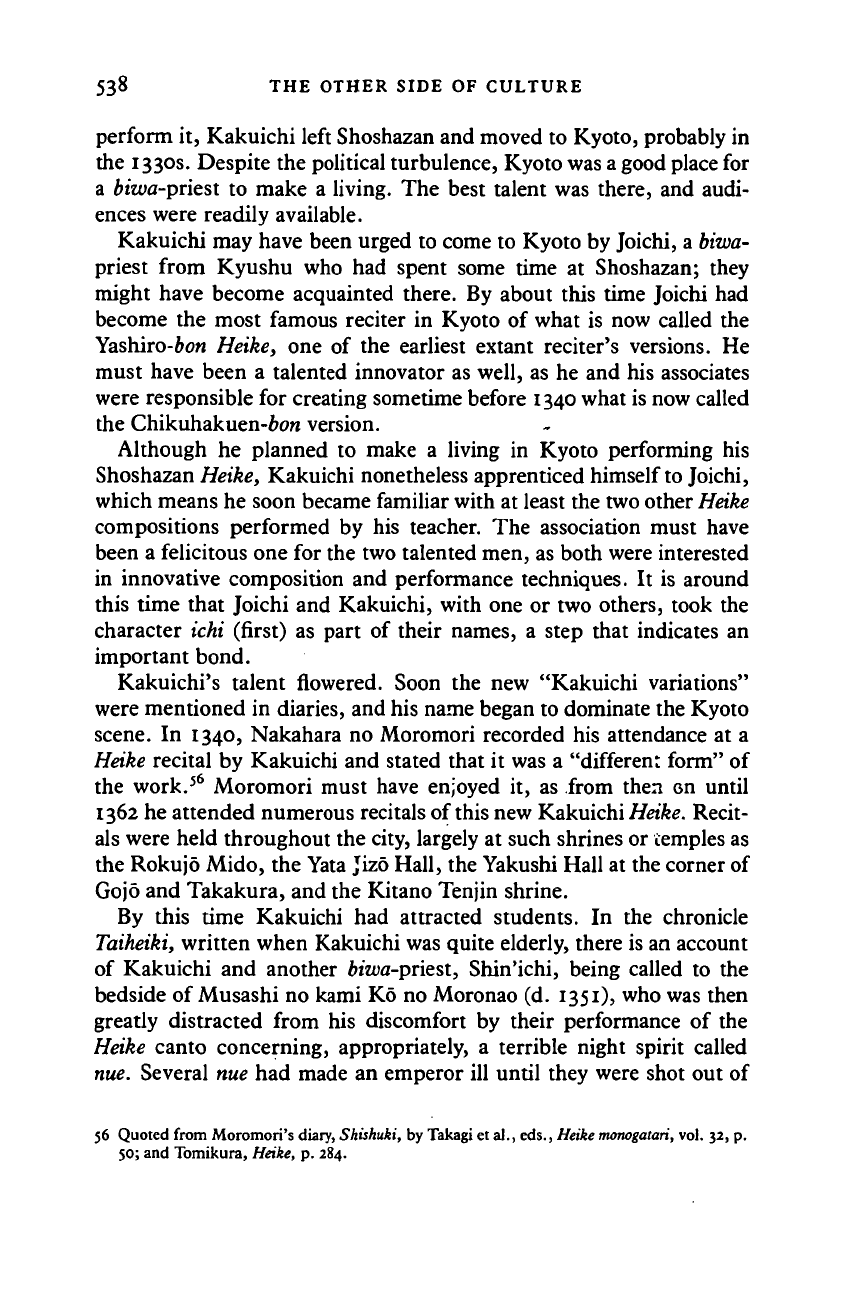
538 THE OTHER SIDE OF CULTURE
perform it, Kakuichi left Shoshazan and moved to Kyoto, probably in
the 1330s. Despite the political turbulence, Kyoto was
a
good place for
a
fo'zua-priest
to make a living. The best talent was there, and audi-
ences were readily available.
Kakuichi may have been urged to come to Kyoto by Joichi, a biwa-
priest from Kyushu who had spent some time at Shoshazan; they
might have become acquainted there. By about this time Joichi had
become the most famous reciter in Kyoto of what is now called the
Yashiro-ion Heike, one of the earliest extant reciter's versions. He
must have been a talented innovator as well, as he and his associates
were responsible for creating sometime before 1340 what is now called
the Chikuhakuen-ion version.
Although he planned to make a living in Kyoto performing his
Shoshazan
Heike,
Kakuichi nonetheless apprenticed himself
to
Joichi,
which means he soon became familiar with at least the two other
Heike
compositions performed by his teacher. The association must have
been a felicitous one for the two talented men, as both were interested
in innovative composition and performance techniques. It is around
this time that Joichi and Kakuichi, with one or two others, took the
character ichi (first) as part of their names, a step that indicates an
important bond.
Kakuichi's talent flowered. Soon the new "Kakuichi variations"
were mentioned in diaries, and his name began to dominate the Kyoto
scene. In 1340, Nakahara no Moromori recorded his attendance at a
Heike
recital by Kakuichi and stated that it was a "different form" of
the work.
56
Moromori must have enjoyed it, as from then on until
1362 he attended numerous recitals of
this
new Kakuichi
Heike.
Recit-
als were held throughout the city, largely at such shrines or temples as
the Rokujo Mido, the Yata Jizo Hall, the Yakushi Hall at the corner of
Gojo and Takakura, and the Kitano Tenjin shrine.
By this time Kakuichi had attracted students. In the chronicle
Taiheiki,
written when Kakuichi was quite elderly, there is an account
of Kakuichi and another 2>m>a-priest, Shin'ichi, being called to the
bedside of Musashi no kami Ko no Moronao (d. 1351), who was then
greatly distracted from his discomfort by their performance of the
Heike canto concerning, appropriately, a terrible night spirit called
nue. Several nue had made an emperor ill until they were shot out of
56 Quoted from Moromori's diary, Shishuki, by Takagi et al., eds., Heike
monogatari,
vol. 32, p.
50;
and Tomikura, Heike, p. 284.
Cambridge Histories Online © Cambridge University Press, 2008
